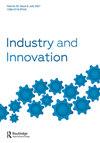Innovation dynamics in the age of artificial intelligence: introduction to the special issue
IF 4.2
3区 管理学
Q1 ECONOMICS
引用次数: 1
Abstract
ABSTRACTIn this paper, we discuss the impact of artificial intelligence (AI) on innovation dynamics and argue that AI has affected innovation dynamics in at least two distinct ways. First, innovation using AI has unique dynamics that are characterised by data playing a central role and the increasing importance of external collaboration; however, data security and privacy issues also present new risks to external collaboration. When innovating in AI, collaboration with customers and competitors is critical, yet there are considerable risks associated with data sharing. Second, unique organisational challenges emerge during the diffusion of AI innovations, because adopting AI in an organisation not only results in the need for additional employee competencies but also challenges organisational power structures. We also discuss the merits of AI as a general purpose technology and argue that conclusions about AI in relation to innovation dynamics are likely to change when generative AI is widely adopted.KEYWORDS: Artificial intelligenceinnovation dynamicsinnovation processinnovation collaborationorganisational changeJEL CLASSIFICATION: O31O33O36 Disclosure statementNo potential conflict of interest was reported by the author(s).Notes1 The acronym ‘GPT’ is commonly used to represent both ‘general-purpose technology’ and ‘generative pretrained transformer’. The latter refers to the neural network architecture developed by OpenAI in 2018 that powers the ChatGPT system. Variants of the third generation and GPT-4 are used in this system, which was released in late 2022 and has sparked widespread discussion about AI among both mainstream audiences and academia. In this paper, ‘GPT’ represents ‘general-purpose technology’.人工智能时代的创新动态:专刊导论
摘要本文讨论了人工智能(AI)对创新动态的影响,并认为AI至少以两种不同的方式影响着创新动态。首先,利用人工智能进行创新具有独特的动力,其特点是数据发挥核心作用,外部协作的重要性日益增加;然而,数据安全和隐私问题也给外部协作带来了新的风险。在人工智能领域进行创新时,与客户和竞争对手的合作至关重要,但与数据共享相关的风险相当大。其次,在人工智能创新的传播过程中出现了独特的组织挑战,因为在组织中采用人工智能不仅需要额外的员工能力,而且还挑战了组织的权力结构。我们还讨论了人工智能作为通用技术的优点,并认为当生成式人工智能被广泛采用时,关于人工智能与创新动态相关的结论可能会发生变化。关键词:人工智能;创新动态;创新过程;创新协作;组织变革;注1缩写“GPT”通常用于表示“通用技术”和“生成预训练变压器”。后者指的是OpenAI在2018年开发的神经网络架构,为ChatGPT系统提供动力。该系统使用了第三代和GPT-4的变体,该系统于2022年底发布,引发了主流受众和学术界对人工智能的广泛讨论。在本文中,“GPT”代表“通用技术”。
本文章由计算机程序翻译,如有差异,请以英文原文为准。
求助全文
约1分钟内获得全文
求助全文
来源期刊

Industry and Innovation
Multiple-
CiteScore
8.10
自引率
7.70%
发文量
41
期刊介绍:
Industry and Innovation is an international refereed journal presenting high-quality original scholarship of the dynamics of industries and innovation. Interdisciplinary in nature, Industry and Innovation is informed by, and contributes in turn to, advancing the theoretical frontier within economics, organization theory, and economic geography. Theoretical issues encompass: •What are the institutional underpinnings for different organizational forms? •How are different industrial structures and institutions related to innovation patterns and economic performance?
 求助内容:
求助内容: 应助结果提醒方式:
应助结果提醒方式:


